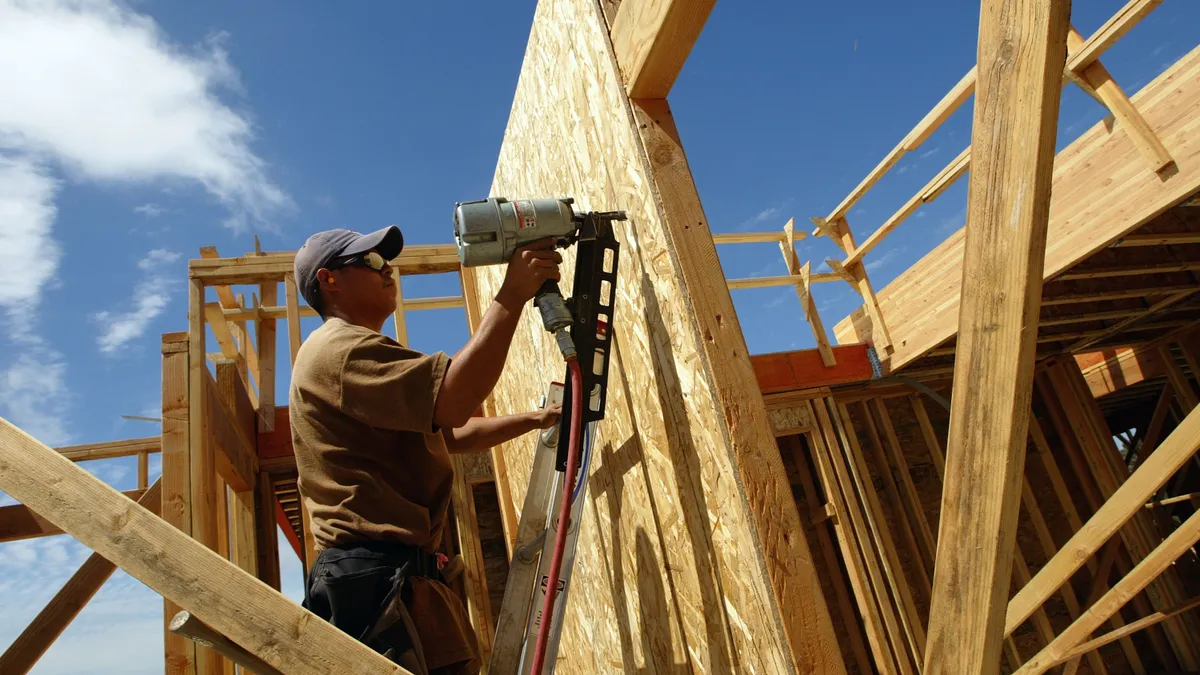U.S. commercial and residential builders breathed a sigh of relief last month when softwood lumber prices dropped more than 30% after reaching an all-time high in May.
Although prices still remain elevated, they have come down to a more manageable level, experts told Construction Dive.
These fluctuations in the price of lumber are related to the supply chain, said Daniel Pomfrett, vice president at Cumming, a project and cost management firm. Now that lumber prices have started to decline, Pomfrett said contractors should not expect the upward spikes that characterized earlier pandemic stages.
"I think we're now starting to see that demand rise above as some people held back their projects in that pandemic period," said Pomfrett. "But the supply chains, in actually getting that raw material, that's really where we've seen that sort of pressure that's being built up and so, as that pressure is being released, what we're seeing is that the prices are coming down."
Lumber prices remain above pre-pandemic levels, despite dropping below the peak price observed in May 2021, according to Associated Builders and Contractors Chief Economist Anirban Basu. Though massive spikes are unlikely going forward, Basu said there continues to be "significant volatility."

A lot of lumber production comes from Washington state, said Pomfrett, which is experiencing a high number of COVID-19 cases. Anecdotally, Pomfrett said this stop-start nature of operations "is going to affect the production." Some Canadian producers have also cut production due to several factors, including wildfires, resin shortages and falling prices. However, with prices still elevated relative to pre-pandemic levels, the expectation is that production will continue to rise to meet demand, said Basu.
But since the pandemic reduces business confidence and interrupts production, contractors can expect fewer additions to capacity, which pushes prices higher, said Basu. At the same time, the variant suppresses confidence among consumers as well, which may cause some home buyers to postpone purchases, reducing new unit construction. That would suppress lumber prices, said Basu.
Dealing with delays
As lumber prices reached record levels earlier in the summer, many single-family home builders decided to postpone production. With the price of lumber, steel and other materials so elevated, spec building is riskier, said Basu.
On the commercial and multifamily side, project owners are delaying construction in some cases, he said.
In order to minimize disruptions from the ups and downs of the price of lumber and other building materials, Granger Hassmann, vice president of preconstruction and estimating for Adolfson & Peterson Construction, a Minnesota-based general contractor, said it’s important to be "very proactive." He said there are delays on the manufacturing side that can't be prepared for, so being flexible by considering different materials, systems or manufacturers is crucial.
"A procurement cycle may have been six weeks to two months in the past, and now it's maybe a week, it's just all about speed and management," said Hassmann. "This isn't the usual sequential process of you go after a project, you win the job, you wait for a contract, you start the process of building. You have to be very proactive."
Rising labor costs
Along with high material costs, supply chain disruptions and the COVID-19 delta variant threat continue to slow the construction industry’s recovery from the pandemic.
As material prices level off, labor has become the dominant source in driving construction costs, Pomfrett said.
"If you take lumber markets, for example, even though lumber prices may come down, there are still going to be price increases [on the project] as a whole because labor skillset shortages are out there," said Pomfrett. "As people come back with more construction projects, we're going to have more work coming than we have for labor."
Workers have become more expensive, and the construction industry unemployment rate is back below 5%, suggesting labor costs will continue to rise "at an uncomfortable pace" among contractors into 2022, said Basu. For this reason, some project owners have been postponing project start dates since their projects are no longer financially feasible.
"If it were not for the delta variant, the economy would be racing ahead right now," said Basu. "Instead, the third quarter will usher forth only mediocre economic growth. That will keep the Federal Reserve in stimulative mode a bit longer than otherwise would be the case."






















